Featured in our City on Fire: Chicago 1871 exhibition is a 40-feet-long painting study created as a guide for a larger Chicago Fire Cyclorama painting, which was displayed in Chicago in 1892-93 in a round building constructed for visitors to have an immersive experience. You can take an in-depth look at the painting study in our latest Chicago00 experience: 1871 Chicago Fire, created for the 150th anniversary of the Great Chicago Fire.
Here, Carl Smith, Franklyn Bliss Snyder Professor of English and American Studies and Professor of History, Emeritus, at Northwestern University, writes about this history of cycloramas and how the Chicago Fire Cyclorama came to be.
Large as it is, the Chicago History Museum’s painting of the Great Chicago Fire examined here is a preliminary version of one ten times as big. At approximately fifty by 400 feet, the latter painting was almost a third as wide as a football field and forty feet longer. It was on display to paying viewers from the spring of 1892 to the autumn of 1893 in a specially constructed building on Michigan Avenue between Monroe and Madison Streets in downtown Chicago. The main feature of the building was its capacious central circular room, sixty feet high and almost 130 feet in diameter, on whose wall the enormous painting was mounted. A stairway led visitors to a platform in the center of this room, where they found themselves surrounded by what advertisements in the Chicago papers proclaimed was “a marvelous representation of an event that is without parallel in the history of civilization.”
The scale of this colossal artwork, its 360-degree vista with multiple vanishing points, and its meticulous attention to detail, combined with a seamless visual transition between visitors and the painting, were all intended to simulate the experience of being present at the actual fire. A successful cyclorama such as this one—much like a 3D film or a set of virtual reality goggles—provided an exciting and even unnerving visual and psychological experience.
By the 1890s, cycloramas were a common form of metropolitan entertainment more than a century old. The earliest examples appeared in London in the late 1780s, quickly followed by cycloramas in cities across Europe and in the young American republic. Favored subjects included contemporary local settings but usually places and moments more distant in space and time. Among the latter were natural wonders like Niagara Falls, dramatic scenes from the Bible like the Crucifixion, and, most of all, great historical events such as the destruction of Pompeii and especially famed sea and land battles.
The heyday of the cyclorama in the United States was the last three decades of the nineteenth century, by which time the rapidly urbanizing nation contained a substantial number of cities with enough people who had the discretionary income and time needed to support attractions that were costly to produce. Between 1850 and 1880, the number of US municipalities with 100,000 or more people jumped from six to twenty. By 1900 there were thirty-eight such cities, half of them with a population of over 200,000.
The battles of the Civil War, fresh in memory, were the most popular subjects for cycloramas in the United States. Americans could transport themselves to the epic engagements at Bull Run, Vicksburg, Missionary Ridge, Shiloh, Fort Donelson, Chattanooga, and Atlanta, and multiple versions of Gettysburg, not to mention the clash between the ironclad ships Monitor and Merrimack. Soon post-Civil War military encounters, notably the 1876 defeat of Custer and his cavalrymen by the Lakota and other Indigenous peoples of the Great Plains, would join the cyclorama repertoire.
A single cyclorama remained on view in a particular venue for several months, perhaps even a year or longer if it kept drawing customers. A single cyclorama would often “play” in a scheduled series of cities. Amidst the hurly-burly of urban cultural life, cycloramas and related jaw-dropping visual productions competed with many other forms of staged entertainments. At the time the Chicago Fire Cyclorama opened, local theatergoers’ options included the Chicago Orchestra conducted by maestro Theodore Thomas, Gilbert and Sullivan’s H.M.S. Pinafore, the Lillian Russell Opera Comique production of La Cigale, the Cornell University Glee and Banjo Clubs, Haverley’s Minstrels, and trained animal shows such as Kohl & Middleton’s Educated Equines. There were also sporting events and a range of museums, whether of painting and sculpture, animal and plant specimens, or historical artifacts and oddities that were frequently as dubious as they were fascinating.
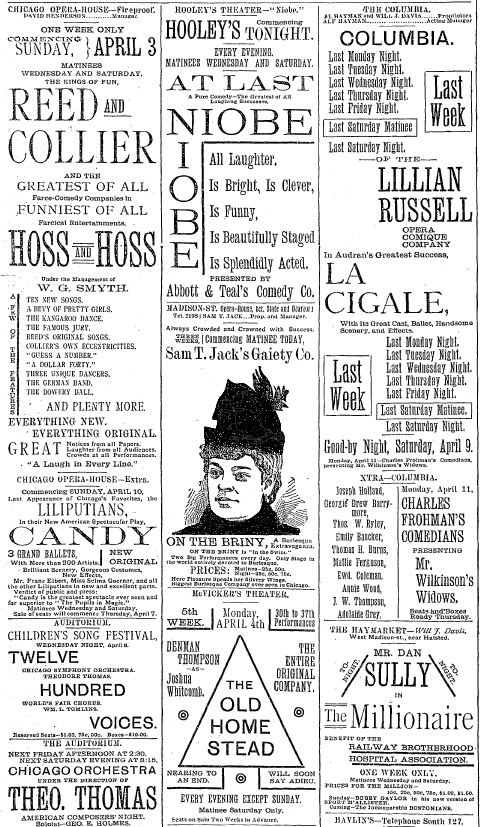
Theater advertisements, Chicago Tribune, April 4, 1892.
As one of the country’s biggest cities and the center of its transportation and communications network, Chicago was a prime location for cycloramas. The first cyclorama in Chicago was apparently a view titled Paris by Moonlight mounted in 1874 in the immense Inter-State Exposition Building. With a quarter million square feet of floor space, that structure had been erected the year before for a trade fair whose main purpose was to declare that Chicago had indeed risen from the flames. Located along the east side of Michigan Avenue and centered on Adams Street, it would host many other events and activities until it was torn down in the early 1890s to make way for the Art Institute of Chicago, which, much expanded, occupies the site today.
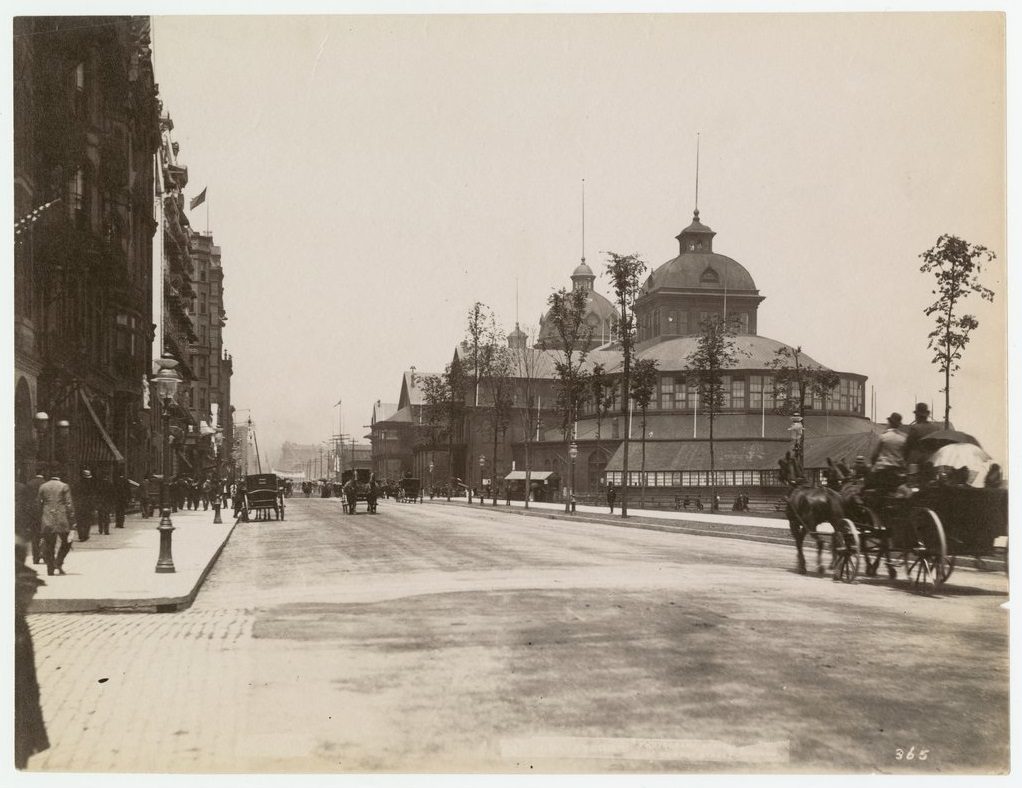
nter-State Exposition Building at Michigan Avenue and Adams Street, c. 1890; J. W. Taylor, photographer. CHM, ICHi-064394.
By the mid 1880s there were three permanent cyclorama buildings in downtown Chicago. Two were across the street from one another, on the southeast and southwest corners of Wabash Avenue and Hubbard Court, now Balbo Street. The one to the west hosted the most enduring cyclorama in Chicago—one of French artist Paul Philippoteaux’s several renditions of the Battle of Gettysburg. When the Chicago Fire Cyclorama opened in 1892, the Gettysburg painting had been on display for a full decade. In the same ten years, the cyclorama building on the east side of Wabash Avenue had hosted The Siege of Paris, The Battle of Lookout Mountain, Jerusalem and the Crucifixion, and Niagara Falls.
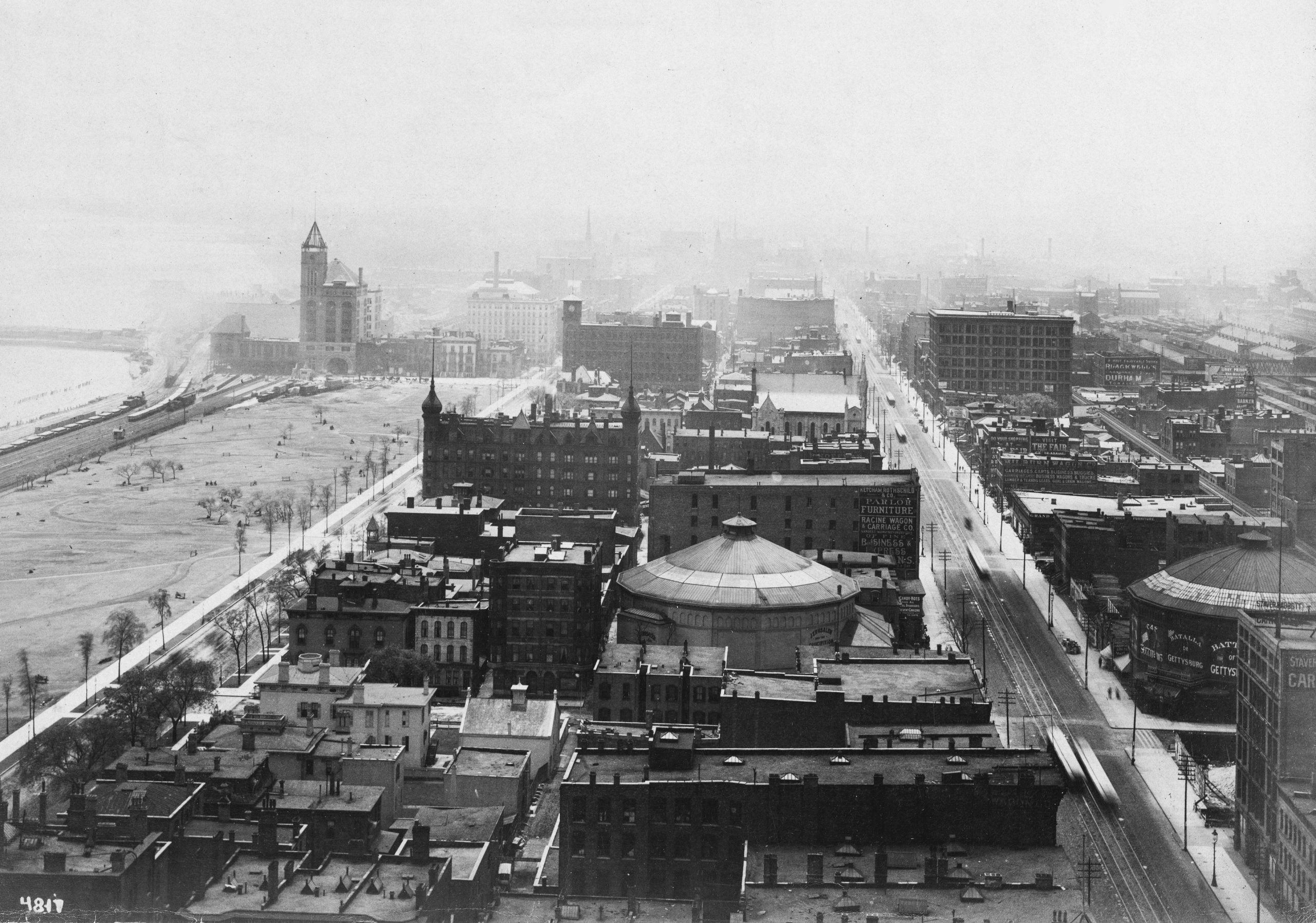
Cyclorama Buildings at Wabash and Hubbard (with the rounds roofs), looking south, c. 1895–1900. CHM, ICHi-005715.
The Chicago Fire Cyclorama building between Madison and Monroe Streets on Michigan Avenue was six blocks to the north and one to the east of the venues on Wabash, on land owned by the family of mechanical reaper magnate Cyrus McCormick. It was erected in 1885 to host The Battle of Shiloh.
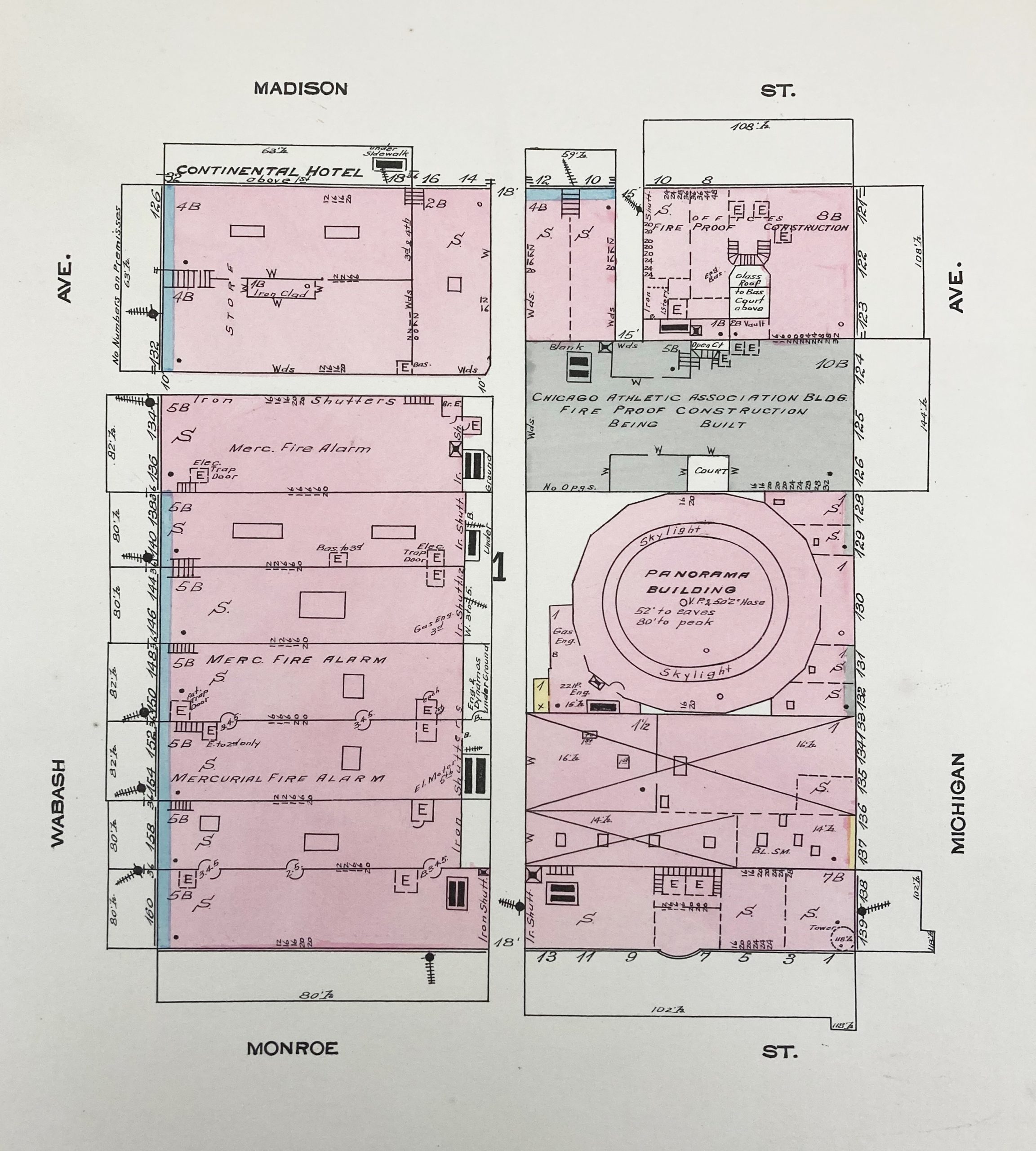
Fire Insurance Map showing location of the cyclorama building (here referred to as the Panorama Building) on Michigan Avenue between Monroe and Madison Streets. Block Book of Chicago, Rascher Insurance Map Publishing Co., 1893.
When plans were announced for the 1893 World’s Columbian Exposition, the certainty of a major spike in visitors to Chicago inspired backers of all sorts of entertainments to try to cash in. Rand McNally & Company’s Bird’s-eye Views and Guide to Chicago, published in 1893 in anticipation of travelers from around the country and world, stated that there were now five cycloramas in the city. During the run of the fair, there would be six. The three newer ones in addition to the three already downtown were in temporary quarters close to the main exhibition buildings of the Exposition, which were located along the lakefront between Fifty-Seventh and Sixty-Seventh Streets in Jackson Park.
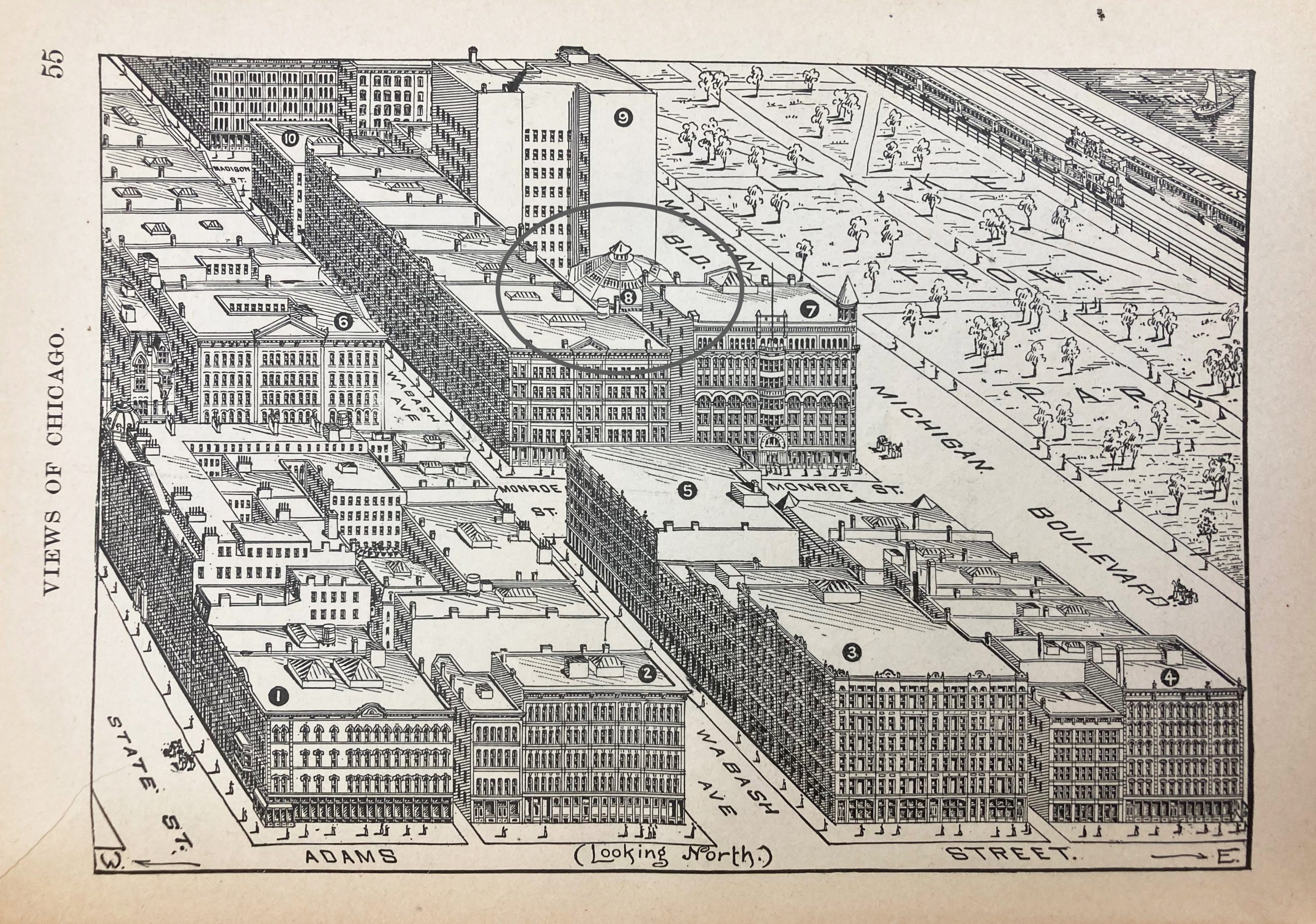
View of Fire Cyclorama Building (in oval) from Rand McNally & Co.’s Bird’s-Eye Views and Guide to Chicago, 1893, p. 55.
On the Midway Plaisance, near such attractions as Carl Hagenbeck’s performing wild animals, the recreation of a street in Cairo, and the first Ferris Wheel, one could view cycloramas of the Hawaiian volcano Kilauea and the Swiss Alps. A few blocks away, at Stony Island Avenue and Fifty-Seventh Street, was The Battle of Chattanooga, whose opening was delayed when, in April, what was described as “a medium wind” blew down the flimsy structure intended to house it.
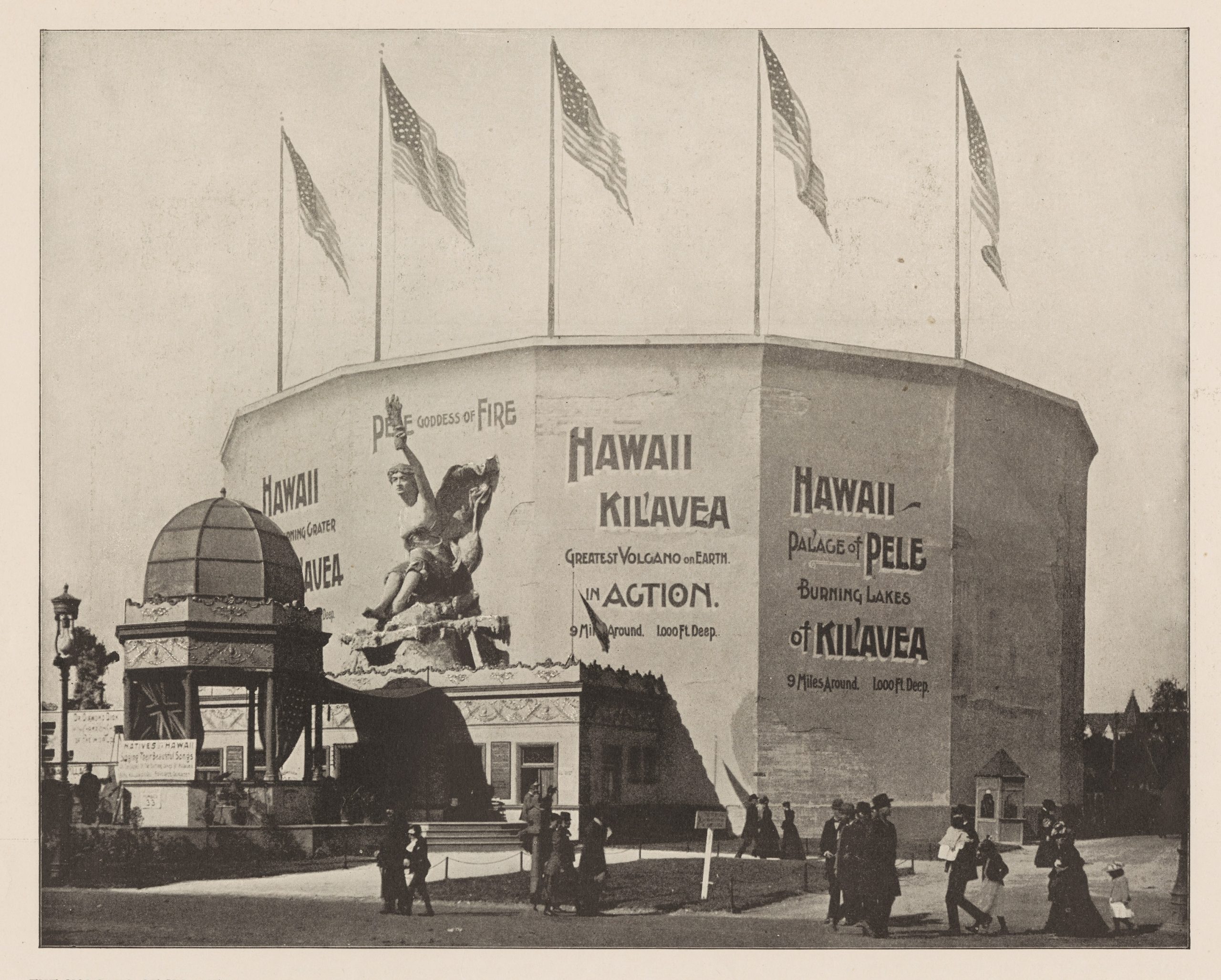
Hawaii Kilauea Cyclorama on the Midway, 1893. CHM, ICHi-092991.
The entrepreneurs behind the Chicago Fire Cyclorama were Isaac N. Reed and Howard H. Gross, whose partnership included similar projects in Melbourne and London as well as Chicago. According to cyclorama scholar Eugene Meier, Gross had a hand in close to thirty cycloramas. Gross also oversaw the preparation of seven large paintings of scenes of California for the state’s Spanish colonial-style building at the Columbian Exposition.
It was Gross who in 1905 donated the smaller preliminary version of the painting owned by the Chicago History Museum. CHM’s records indicate that Gross did not give the painting directly but through prominent Chicago grain commission merchant Frank G. Logan. Logan was a collector both of Native American artifacts and items relating to John Brown and Abraham Lincoln. The Native American artifacts were exhibited by the Anthropology Department of the 1893 World’s Columbian Exposition, the Brown and Lincoln materials in the fair’s Illinois Building.
Logan accompanied the deed gift of the study with several legal documents. These documents reveal that the Chicago Fire Cyclorama Company filed its incorporation papers with the State of Illinois on April 13, 1891, and received approval on June 9. It gave its address as a building on Dearborn Street.
Daniel J. Hubbard, a real estate man whose office was in the same building, was officially the president of the company, though Gross was the driving force behind the production of the cyclorama. He was also by far the main investor. Of its 1,250 shares of stock, valued at one hundred dollars each, Gross owned 935. The two next largest backers, one of whom was Hubbard, owned only fifty shares. Another investor, with twenty-five shares, was pioneering professional baseball player and executive Albert G. Spalding.
Gross, Hubbard, Spalding, and the other owners stated that the purpose of their corporation was “to buy and sell, and to exhibit, Cycloramas, and particularly to exhibit a Cyclorama of the Chicago Fire of the year A.D. 1871, and for the purpose of conducting any other amusement or amusements, connected with such exhibition.”
Another document states that at a special meeting on January 18, 1892, the stockholders approved a doubling of the number of shares to 2,500 and of its valuation to $250,000. This figure was cited in newspaper advertisements that claimed the fire cyclorama was the “Most Expensive Work of Art Created in the History of the World.”
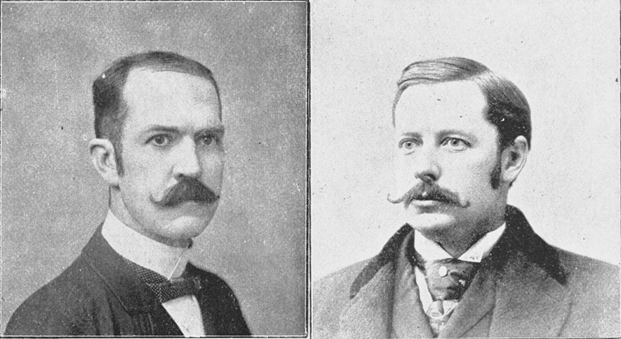
Isaac N. Reed (left) and Howard H. Gross (right), from A Story of the Chicago Fire, by Rev. David Swing, 1892.
Reed and Gross hoped to begin admitting viewers to the Chicago Fire Cyclorama on October 11, 1891, almost exactly twenty years after the fire. When they missed this deadline, the reason given in the newspapers was “the difficulty in procuring data” on the fire and “the absolute necessity of exactness of detail in the drawing.” Gross claimed that he had spent more than a year gathering information, in which time he had collected 8,500 photographs and conducted interviews with some 1,300 people, at a cost of $120,000. To obtain these resources, he placed ads in the local newspapers appealing to those who had experienced the fire. He also purchased photographs from P. B. Greene, one of the several local photographers who marketed stereographs of the disaster. He appears to have tried unsuccessfully to include Catherine O’Leary in his interviews. All this effort, he insisted, ensured the fidelity of the painting to its subject. Gross challenged any survivor of the fire “to point out a single detail which was not historically and architecturally accurate.”
By the late nineteenth century, cyclorama makers followed a standard set of procedures and techniques. Working from the documentary records that Gross had assembled, artists created a one-tenth scale version, of which the Chicago History Museum’s painting is an example. At this stage, they worked out compositional issues and how they wished to handle color and light. The next step was to transfer this version in detailed outline to the full-size cyclorama. To accomplish this, they divided the former into a grid of 100 squares and photographed these squares onto glass plates. They then projected these images at ten times actual size onto the much larger final canvas (or linen) and used these projections to trace the smaller version on it. As was the case with the Chicago Fire Cyclorama, the artists made numerous alterations between the preliminary and the final version, though not in the overall composition.
To reach everywhere on the larger surface, artists worked from several multilevel platforms that moved along a set of circular tracks in front of the painting. Just hanging or taking down the enormous work was a daunting task, requiring not only brute strength but also a certain delicacy, since cycloramas, which weighed several tons, were easily damaged. There were many injuries, some fatal, most attributable to falls from or the collapse of a platform.
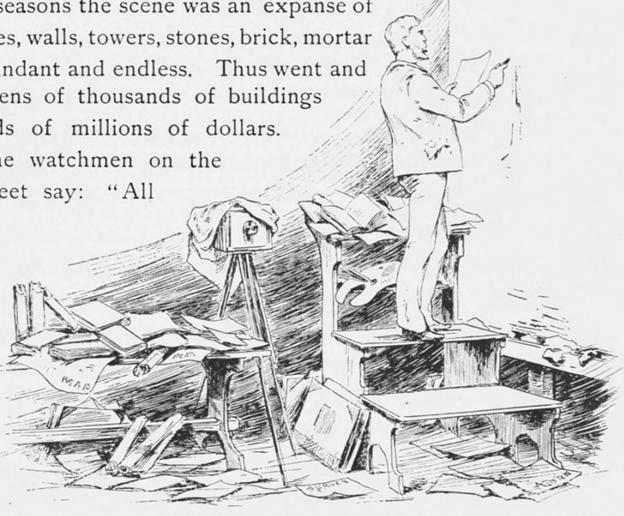
Artist working on the Chicago Fire Cyclorama, from A Story of the Chicago Fire, by. Rev. David Swing, 1892. Note the reference books, drawings, and camera, all of which were important to the creation of a cyclorama.
The artists treated the floor area between the center spectators’ platform and the painting into a stage set of sorts, using landscaping and props in constructing a three-dimensional foreground designed to blend into the two-dimensional painting on the wall. In addition, they hired live models for the drawings of figures. They also arranged lighting to create the most dramatic effects. Many cyclorama buildings had skylights, but cyclorama makers also skillfully employed artificial illumination. By the close of the nineteenth century this meant electric lights. The promoters might add live or, later on, recorded music. A guide or even an orator might be on hand to enrich the viewers’ visit.
Like other cyclorama impresarios, Reed and Gross recruited a talented group of artists to recapture the fire in all its vivid intensity. Salvador Mége of Paris and Edward James Austen of London, both experienced cycloramists, laid out the composition and decided on the colors employed. Austen suffered serious injuries in a fall from a platform, which contributed to the delay in completing the project. Oliver Dennett Grover, a faculty member of the School of the Art Institute (which dates to 1879), was responsible for the many figures in the painting, with assistance from Charles Corwin and Edgar S. Cameron, who was also an art critic for the Chicago Tribune. Paul Wilhelm, a Chicagoan from Dusseldorf, Germany, did much of the foreground work, including the vessels on the main branch of the Chicago River. The horses were done by animal painter Richard Lorenz, a German-born artist based in Milwaukee. Another Frenchman, Albert Francis Fleury, was credited for the structures by the lake and river, while C. H. Collins’s hand is seen in the blocks of buildings destroyed by the fire.
Some of these artists accomplished other important and enduring things in Chicago besides their contributions to this and other cycloramas. Fleury, who also was associated with the School of the Art Institute, executed many superb drawings of the Chicago cityscape and painted the large murals on the sides of the interior of the Auditorium Theatre that accompany architect Louis Sullivan’s odes to spring and fall inscribed on these walls. Corwin would later specialize in another form of virtual reality, the backgrounds of dioramas in the Field Museum, whose current building opened in 1921. William Leftwich Dodge, who had studied with another fire cyclorama artist, Jean-Léon Gérôme, at the École des Beaux Arts in Paris, also did murals for the Administration Building at the Columbian Exposition (and the Library of Congress in Washington, DC).
The Chicago Fire Cyclorama opened at 7:00 p.m. on Wednesday, April 6, 1892. Notices stated that the painting could be viewed twelve hours a day, from 10:00 a.m. to 10:00 p.m., seven days a week. Regular admission was fifty cents (half that for children), the same price as entry to the entire World’s Columbian Exposition main grounds or a single ride on the Ferris Wheel. This was at a time when a laborer might earn five or six dollars a week. Reed and Gross ran large advertisements in the daily papers declaring their latest marvel “the most thrilling spectacle art ever presented to human vision.”
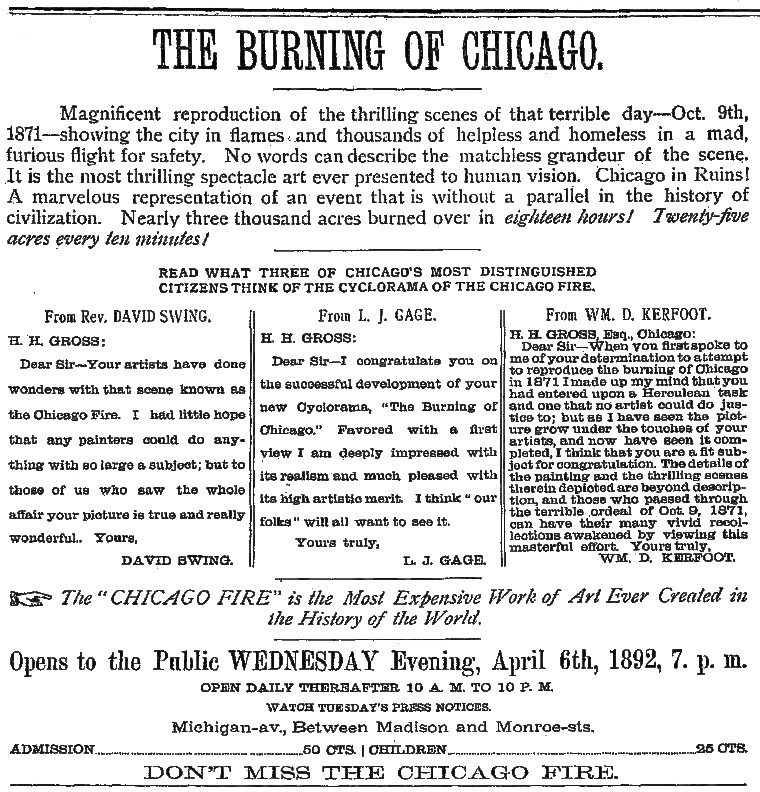
Advertisement for the Chicago Fire Cyclorama, Chicago Tribune, April 3, 1892.
In addition to paying their admission, visitors could spend another ten cents on an illustrated souvenir booklet. Titled The Story of the Chicago Fire, it consisted mostly of a personal account of the disaster by the Reverend David Swing, one of the most popular ministers in the city. This was followed by factoids pertaining to the fire (“The loss in property was a million dollars every five minutes!”) and the painting, as well as profiles of Reed, Gross, and their artists. The booklet calculated that the almost 20,000 feet of surface area was covered with nearly two tons of paints and oils, adding, “The work, if it had been done by one man, would have required over twenty years to complete.”
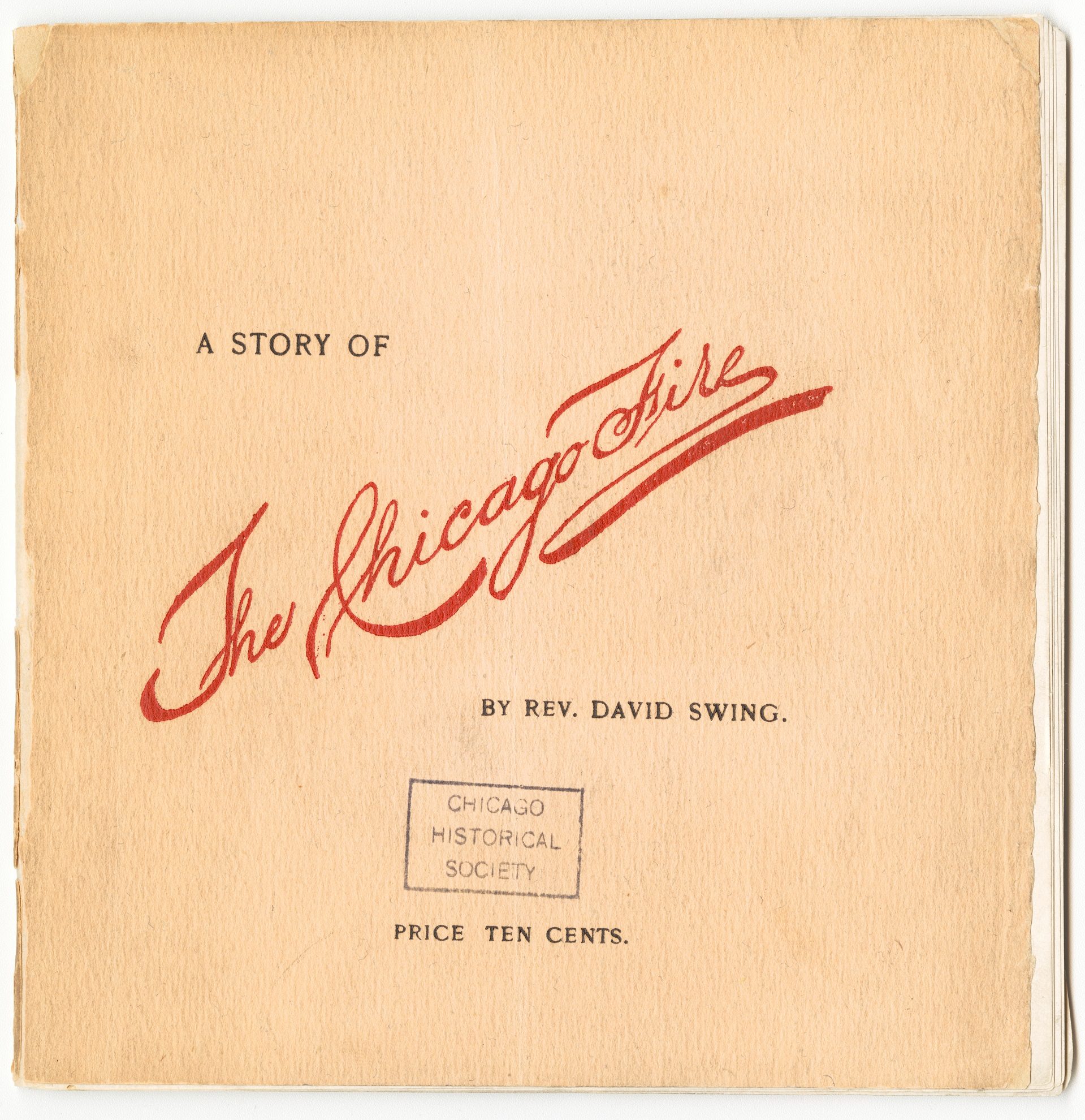
Cover of A Story of the Chicago Fire, 1892. CHM, ICHi-1788417-001.
The fire cyclorama remained on display for some nineteen months, until the Columbian Exposition closed its doors at the end of October 1893. It was forced to suspend operations for a short period when in November 1892 the neighboring Illinois Athletic Association (also called the Chicago Athletic Association, and now the Chicago Athletic Association Hotel) next door caught fire. In battling the blaze, the fire department demolished the Fire Cyclorama building’s glass roof and flooded its interior, forcing considerable repairs. According to one reporter, “The boys mistook the painting for the real fire.”
The Chicago Fire Cyclorama appears to have done a decent but not remarkable business. The Rand McNally & Co. guidebook to the city stated that the number of patrons in the first year was 144,000, but this is not authoritative and might be based on an exaggerated claim by the promoters. Given that many visitors were children, who were admitted at a discount, it seems likely that the enterprise either made little money or even failed to break even. In any event, Gross and Reed did not keep it open after the close of the Columbian Exposition.
Gross proposed another cyclorama, this one a grand vista of the Exposition. Backers of the proposal included noted Chicago architect Daniel Burnham, who had been the fair’s highly praised director of construction; financier and future US Treasury Secretary Lyman Gage; railroad car manufacturer George Pullman; Chicago Tribune owner Joseph Medill; and Bertha Honoré Palmer, wife of hotelier Potter Palmer, benefactor of the Art Institute and the leader of Chicago society.
But by the mid-1890s, after about a decade in the cyclorama business, Gross left it to pursue not only other commercial ventures but also several civic-minded undertakings. Throughout his career he moved from one project to another or was engaged in a few at the same time.
When Chicagoans learned the Fire Cyclorama’s days were numbered and that there was talk of moving it to London, some called for finding it a permanent home in the city. The leading suggestion was to place it in a building in one of the city’s parks—the West Side’s Garfield Park was the most frequently mentioned candidate—where admission would be nominal or without charge. Nothing came of this. In 1900 Gross offered to donate the cyclorama on the condition that it be properly housed and free to the public. Again, there was a proposal to locate it in a handsome new beaux arts building in a park, but this, too, went nowhere. The mammoth fire cyclorama painting remained rolled up in storage near Gross’s home a few blocks west of the South Side’s Washington Park. In 1913, by which time it probably had deteriorated a great deal, it was sold as scrap to a junk dealer for two dollars.
By then the era of the cyclorama had passed. Over the previous decades artists and inventors were developing even more arresting visual displays. Of special interest is something called the Scenograph, created by Fire Cyclorama artist Edward James Austen, which opened in the summer of 1894 in New York’s Madison Square Garden before moving to Boston. Its central subject was Chicago’s World’s Columbian Exposition (it is not clear whether this had any connection to the project in which Gross had been involved). The Scenograph was not a 360-degree vista but a broad bird’s-eye view, as if from a balloon 6,000 feet out into the lake and 600 feet in the air. As a result, it encompassed not only the fair, but also metropolitan Chicago and the surrounding countryside.
The Scenograph received rave reviews in the New York and Boston papers. Critics noted how successfully Austen overcame the major liability of the cyclorama—its static quality. Working wonders with lighting effects, Austen somehow made the sun rise and set as boats glided across the lake and trains bustled along their tracks.
There was no way cycloramas could compete with the latest big step in virtual reality, the motion picture, which existed in primitive form by the early 1890s. Within a decade after the Chicago Fire Cyclorama closed, the Chicago firm of Essanay Studios, which employed Charlie Chaplin and numerous other silent film notables, was making movies downtown and planning a move to new facilities it would construct on Argyle Street in Uptown, which still stand.
Cycloramas continued to play in Chicago and other cities for a while, but most cyclorama buildings that did not close survived by finding other uses. They hosted political conventions, flower exhibitions, dog shows, religious revivals, boxing matches, bicycle races, and other events that needed large open interior space. In 1895 the structure that had presented the Chicago Fire Cyclorama, commonly called the Panorama Building, accommodated an exhibition of druggist’s products. The next year it presented a pure food show with all kinds of edible goodies. Soon dogs would disturb the cats at a household pet show held within its walls, which also contained the 1897 poultry and pigeon show sponsored by the National Fanciers’ Association of Chicago. One of the building’s final uses was as the site for the city’s grateful welcome to sailors returning from the war in the Philippines.
Shortly after that, Stanley McCormick, Cyrus’s youngest son, commissioned the top architecture firm of Holabird & Roche to build two buildings on the site of the Panorama Building and a third building just to the south. The three buildings, erected in 1898‒99, were originally leased to prominent wholesale millinery companies. The northernmost of the three, known as the Gage Building, was soon raised to its current height of twelve stories. Its ornamental enameled terra cotta façade, designed by Louis Sullivan, is one of the few buildings in Chicago on which he worked that are still standing.
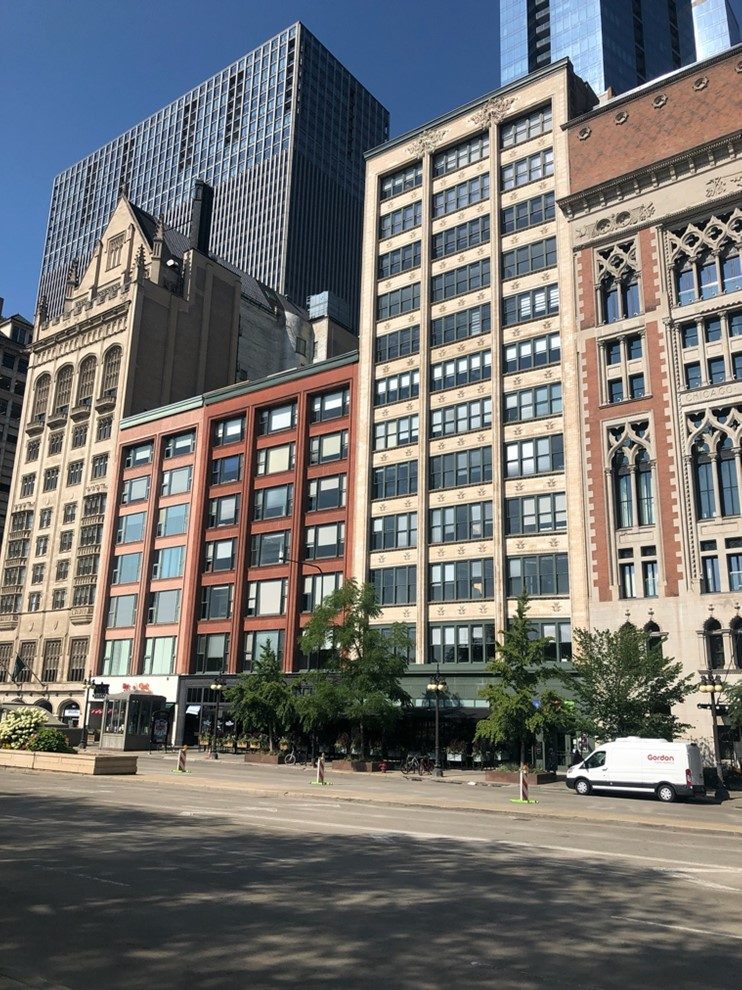
The seven-story red building and the twelve-story building to its left now occupy the site of the Chicago Fire Cyclorama building on the west side of Michigan Avenue, between the University Club and the Chicago Athletic Association Hotel. Millennium Park is across the street. Photograph by Carl Smith.
Cycloramas did not completely disappear. CHM’s study for the Chicago Fire Cyclorama was evidently exhibited in Marshall Field’s in 1921 as part of the department store’s commemoration of the fiftieth anniversary of the Great Fire. A recent count lists about three dozen cycloramas throughout the world. Extant American cycloramas include a relatively early example, artist John Vanderlyn’s 1818 view of Versailles. Originally exhibited in a building constructed in lower Manhattan, it now hangs in the Metropolitan Museum. Two others are in Atlanta, Georgia, and Gettysburg, Pennsylvania. They both are extensively restored nineteenth century paintings of the Civil War battles that took place nearby.
The website of the Battle of Atlanta calls it “one of America’s largest historic treasures.” It adds that the Atlanta History Center, where the painting is mounted, “uses this restored work of art and entertainment, and the history of the painting itself, as a tool to talk about the ‘big picture.’” The Battle of Gettysburg cyclorama calls it “the largest oil-on-canvas painting in North America.” Its website claims that its effect on the viewer is to create the illusion of being in the midst of the drama, “an immersive experience” that visitors describe as “moving,” “riveting,” and “breathtaking.” The same could be—and was—said about the Chicago Fire Cyclorama.
Special thanks to Gene Meier.
Further Reading
- Atlanta History Center, Cyclorama: The Big Picture
- Bernard Comment, The Painted Panorama (New York: Harry N. Abrams, 1999)
- Theodore R. Davis, “How a Great Battle Panorama Is Made,” St. Nicholas 14, no. 2 (December 1886): 99‒112
- Gettysburg Foundation, Gettysburg Cyclorama
- Ralph Hyde, ed., Dictionary of Panoramists of the English-Speaking World
- “Moving a Cyclorama,” Boston Daily Globe, December 7, 1890, 23.
- National Park Service, Cyclorama
- Stephen Oettermann, The Panorama: History of a Mass Medium (New York: Zone Books, 1997)
- David Swing, The Chicago Cyclorama (Chicago, 1892)